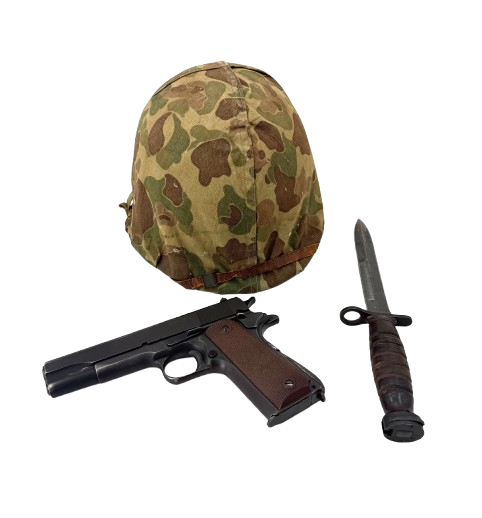Tinian Island: Gateway to Japan and the Atomic Age
USMC M1 Helmet, M1911 Pistol & M8 Bayonet
The Battle of Tinian, fought between July 24 and August 1, 1944, stands as one of the most meticulously planned and executed amphibious assaults of World War II. As part of the broader Mariana and Palau Islands campaign, the capture of Tinian marked a pivotal moment in the Pacific Theater. The operation not only demonstrated the growing tactical sophistication of American forces but also laid the groundwork for the final stages of the war, including the deployment of the atomic bomb.
Located just south of Saipan in the Northern Mariana Islands, Tinian held immense strategic value for both Japanese and Allied forces. For Japan, it was a key outpost in their defensive perimeter, helping to shield the homeland from direct attack. For the United States, it offered an ideal location for airfields capable of hosting long-range B-29 Superfortress bombers. Its capture would bring the Japanese mainland within striking distance and facilitate future operations.
The operation to seize Tinian followed the successful but costly Battle of Saipan. Learning from that experience, U.S. forces, under the command of Lieutenant General Holland M. Smith and Rear Admiral Harry W. Hill, meticulously planned the invasion of Tinian. The island’s geography posed a unique challenge—its western beaches were heavily defended and fortified, while its northern coastline featured narrow, seemingly impassable coral ledges.
In one of the war’s most innovative maneuvers, American planners chose to land forces on the less-defended northern beaches, known as “White Beaches,” utilizing specially constructed ramps and amphibious vehicles to overcome the coral barriers. This decision caught the Japanese off guard and contributed significantly to the success of the operation.
On July 24, 1944, elements of the U.S. 2nd and 4th Marine Divisions began their assault on Tinian. Facing approximately 8,000 Japanese defenders under Colonel Kiyochi Ogata, the Marines advanced with precision and coordination. Unlike previous island battles, the fighting on Tinian was characterized by efficient use of fire support, close air support, and seamless coordination between infantry and armor.
Despite fierce resistance and suicidal counterattacks by Japanese forces, American troops secured the island in just nine days. The battle resulted in the deaths of nearly all of the Japanese defenders, while American forces suffered relatively low casualties—approximately 300 killed and 1,600 wounded.
The rapid capture of Tinian allowed the U.S. military to transform the island into the largest airbase in the Pacific within months. The construction of North Field and West Field enabled the launching of strategic bombing raids over Japan, including the atomic bomb missions over Hiroshima and Nagasaki in August 1945.
Thus, the Battle of Tinian not only represented a tactical and operational success but also became a crucial turning point in the war's trajectory. It showcased the effectiveness of American joint operations, the adaptability of military planning, and the growing dominance of airpower in modern warfare.


